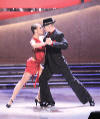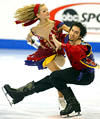| HOME PAGE |
|
JOIN USA SWING NET | |
 Benji & Heidi
|
So you think you can dance? Well, OK. But that's just one element of your overall competition performance. Music selection, costuming, hair, and floorcraft are also a large part of the mix.
We interviewed dozens of professionals - Event Directors, Champion Dancers, Dance Coaches, Fashion Consultants, Make-up Artists, Television Producers, Theatre Performers, and Figure Skating Champions. They all agree - presentation makes a critical difference in the outcome of a competition.
Because Ice Dancing and Ballroom Dancing have been showcased on TV and at major entertainment venues for years, the performers for those genres place extremely high importance on costuming, make-up and performance strategy. The stakes for them are very high. Most have advisors and consultants who work closely with them to craft a complete image. It shows.
By contrast, Swing has not yet reached the same level of prestige and exposure with the national media. As a result, many dancers tend to be more casual in their overall approach to competition, perhaps focusing more of their efforts on choreography than on outfits. But it appears that fans want more.
The USA Swing Net conducted a National Poll among the thousands of dancers who visit this website each month. We asked them to identify the one element of Swing dance competition that they felt needed the most improvement. Comments poured in from a wide range of observers. We listened to it all - from the spectator level to noted instructors and judges who are highly sought after for their advice. The category that topped the list: COMPETITORS' OUTFITS.
There is a universal feeling that competitive dancers don't make enough effort to select outfits that are visually dramatic. The over-use of black material in outfits has been a thorny issue. Some feel it conveys a relaxed mood that exemplifies West Coast Swing. Others feel it is plain boring compared with the more creative outfits seen on TV shows like "So You Think You Can Dance" and "Dancing with the Stars". Bottom line - a majority of WC Swing dancers who participated in our survey felt that costuming is the weakest link in this dance.
Below we address a number of issues relating to competition strategy to help provide valuable insights to dancers in all divisions. Please note that this information is offered in a positive light. It is based upon the points of view of a wide variety of professionals. Some comments are specific, some generalized. Some things are absolutes, others a matter of personal preference. We offer it merely as perspective.
* * * *
SONG SELECTION
Look back at those couples who have been repeat Champions at top competitions. Why have they won so many times over so many years? Well, in addition to having exceptional talent, their song selection has been consistently outstanding. They just know how to pick GREAT MUSIC.
Before you select a song for a dance routine, first ask yourself these questions: "Will it thrill the audience?" "Does it have energy, mood, unique rhythms, interesting breaks, and refreshing transitions?" "Does it have a great beat and great lyrics?" "Does it fit your personal dance style and skill level?" "Does it have unquestionable entertainment value?" Most of all, "Can you WIN with it?" If you can answer "yes" to most of these questions, you probably have a great song. If not, keep looking.
Over the years there have been many couples who have had enormous dance talent but lacked the right kind of song to put their dancing over the top. To change outcomes you often have to change your approach. Soliciting outside advice from music, dance and choreographic professionals who have that special ability to select great music can be a wise strategy. Ask a few judges for their advice, too.
Many couples have consulted for years with premier Swing choreographers who will not only recommend a great song for them but also help choreograph their routine. Even top Pros sound each other out for song ideas. Again, song selection can make you or break you. So, the next time you plan to compete, check your ego at the door and get outside advice from as many sources as you can to be sure that you choose great music that can help you WIN. It's one of the best strategic decisions you'll ever make.
OUTFITS
What are the two biggest complaints about Swing outfits based on the National Poll and informal conversations? Too much BLACK - not enough COLOR! As compared with their Ballroom and Ice Dancing cousins, Swing competition outfits fall far short when it comes to visual impact and creativity.
A decade ago, outfits were flashier and many more women wore stylish skirts and dresses. Outfits seemed to convey a greater sense of "entertainment" back then. In recent years, however, skirts and dresses have given way to slacks and black has become the default color for West Coast Swing. Well, a large segment of the Swing community has spoken and they're asking for change. So, the next time you compete, think about adding some color and imagination to your outfits to energize your fans in the stands. Swing is an entertaining dance - you're outfits should be entertaining, too!
Colors, materials, accents, hair, body coverage - they're all important items. Here's some tips that were offered on the subject of physical presentation:
FLOORCRAFT
If your routine is not mostly centered,
if it travels too much, if it begins or ends in a far corner or drifts
to the
sides of the dance floor, its impact on the largest audience block
directly in front of you becomes diluted. When you
stray too far away from the "sweet spot" and when you force the audience
to follow you around a large dance floor too much, you lose the steady
"radiating effect" that a centered performance brings. Remember, the
audience will only "bounce back" as much energy as you "send out" to
them. If you're too far away, the energy you send - and receive
back - will be significantly diminished.
SUMMARY
When you decide to compete,
consider all these points and try solicit advice from as many outside experts as you can.
Success and winning is based on knowledge, preparation, strategy, and
intelligence.
The more secrets you know and the more you apply them, the more you
improve your chances for victory in any dance competition.
|
||
|
|
|||




